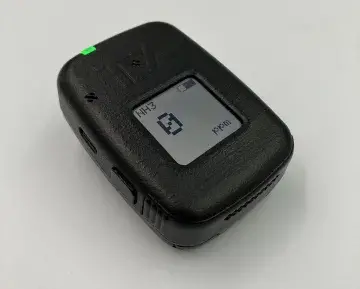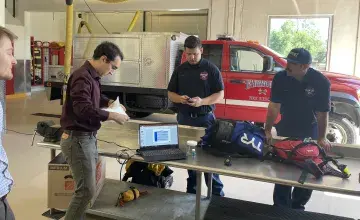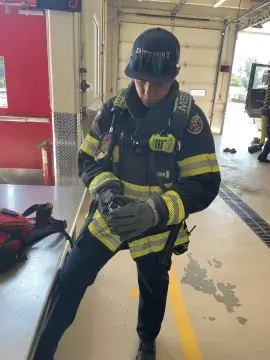New cutting-edge sensors will help responders better protect themselves from dangerous chemicals in the field.
Every day, all types of emergency responders across the nation are dispatched to calls for situations ranging from industrial, agricultural, and commercial accidents to 5-alarm fires. In these moments, we rely on them to render aid swiftly and efficiently, even if it means risking their personal safety. This is why the Science and Technology Directorate (S&T) is leading a new effort to arm responders with state-of-the-art technology that alerts them to toxic industrial chemicals (TICs) that may be present in the field.
S&T’s goal: Support the development (and, ultimately commercialization) of a cost-effective, wearable, customizable, and reusable chemical sensor that allows first-on-scene personnel to respond to a wide variety of emergencies quickly and safely.
An estimated 240 million calls are made to emergency services in the United States every year. “Our emergency responders need to have the most up-to-date technologies and tools that will enable them to safely answer these calls,” said S&T Program Manager Kimberli Jones-Holt. “We are collaborating with several partners to ensure that they have access to these resources, and also enhance existing technologies to provide more convenient and affordable safety capabilities.”

Thanks to the Small Business Innovation Research (SBIR) Program, S&T joined forces with TDA Research inc. (TDA), the U.S. Naval Research Laboratory, the Fairmount Fire Department in Golden, Colorado, and additional government and private stakeholders to develop a portable chemical sensor that detects TICs (e.g., hydrogen sulfide, ammonia, phosphine, hydrogen cyanide, chlorine, and nitrogen dioxide) that firefighters and other similar emergency responders could potentially be exposed to during a response. Following the successful completion of a Phase I contract, TDA was awarded an additional 24-month SBIR Phase II contract to develop a simple low-cost wearable sensor badge, and then continued further development of their technology through a 12-month SBIR Commercialization Readiness Pilot Program (CRPP) award.
“TICs are commonly found in many industries and are often used as a crucial part of manufacturing, refining, and other commercial processes and related activities,” explained Jones-Holt. “As a result, when industrial or chemical emergencies, fires, or natural disasters occur, it’s very likely that firefighters and other first-on-scene personnel will encounter them when they respond to calls in the field.”
“TICs can be easily inhaled, ingested, or absorbed through the skin, causing irritation of the nose, mouth, throat, eyes, and skin,” continued Jones-Holt. “Depending on the type of TIC, prolonged exposure can be deadly. Therefore, it’s crucial that emergency responders are properly equipped to deal with and be protected from them.”
To meet this crucial need, TDA developed and deployed prototype wearable chemical sensor badges with firefighters and emergency responders at the Fairmount Fire Department to demonstrate and verify that the badges could quickly and accurately alert users to the presence of dangerous TICs. These devices are meant to improve situational awareness and enable responders to leave the scene before any harmful exposure and associated injuries occur.
“My hope is that these wearable chemical sensor badges will prove to be an effective and comfortable tool that increases situational awareness and supplements the current chemical and gas sensors that are being used by our first responders,” said Jones-Holt.
Most existing chemical and gas sensor technologies are expensive and bulky, which is not ideal for agencies that often contend with tight budgets for equipment and limited space on vehicles. TDA’s wearable sensor badges will be much more portable, cost approximately $200 each, and utilize easily replaceable colorimetric chemical sensor strips (costing ~$5-10 each). They will also run on rechargeable batteries, giving first-on-scene responders an affordable, cutting-edge tool that can be used repeatedly in the field.
Jones-Holt explains how the wearable chemical sensor badges work. “As their name implies, these chemical sensor badges are small, lightweight, and designed to be clipped onto a jacket or vest so that they don’t restrict the user’s movement or ability to perform critical tasks. They are water- and drop-resistant and designed to be used in rough environments on a daily basis.”

The badges use specialized sensors that sample the air to detect the presence of hydrogen sulfide, ammonia, phosphine, hydrogen cyanide, chlorine, and nitrogen dioxide at trace levels. If any TICs are detected, the sensors will send alerts to the wearer via a colorimetric sensor cartridge strip that displays up to six different colors (depending on which TICs are present) on a LED screen on the front of the badge. The screen will automatically indicate which chemical or gas has been identified, and how much of it is present in the environment (in parts per million). The badge also has vibratory and auditory alarming features that will automatically be triggered during an exposure as well.
This spring (April to June), TDA conducted live field and end user testing with the Fairmount Fire Department. “Firefighters and other emergency responders often work in all sorts of settings where they can be exposed to TICs,” explained Jones-Holt. “We needed to be sure that the wearable chemical sensor badges can function as required and protect them in the field, no matter what type of environment they’re in.”
To assess the ease of use and functionality of the badges, Fairmount firefighters participated in operational drills where they engaged in hands-on operation of the badges. They performed tasks like operating them while donning their protective gear (e.g., coats and gloves), mounting the badge onto their jacket or vest, pressing various buttons on the badge and the on-screen menu, and replacing the colorimetric sensor cartridge strip and battery. All these tests were performed with both gloved and ungloved hands.

Participants drop-tested them, submerged the badges in water, and exposed them to ammonia to verify their ability to detect TICs. Analysis and confirmation of the badges’ abilities to detect the other five TICs was performed at the Naval Research Laboratory prior to the in-person assessment, to protect the participating responders from potential exposure.
After the assessments, TDA surveyed the Fairmount firefighters and EMS responders to gather their input regarding how the badges performed during each set of operational drills and tests. Overall feedback was overwhelmingly positive and indicated that the wearable chemical sensor badges have the potential to be a critical tool for firefighters and other first-on-scene responders.
“Based on comments from the test participants, TDA will work to improve the final iteration of the badges by making them a little bit larger, ruggedizing them with silicone carry cases, increasing their ability to withstand extreme temperatures, modifying the mounting clip so that they won’t dangle if the wearer is bending over or crawling on the ground, and intensifying both the auditory and vibratory alarms that alert the wearer to potential dangers,” said Jones-Holt.
With the success of the field end-user testing made possible through the SBIR CRPP Award, TDA and S&T are looking forward to the future commercialization of the wearable sensor badges.
“It’s our hope that these sensor badges will not only be a critical tool for firefighters and first-on-scene responders, but others in the field as well,” explained Jones-Holt. “We recognize that depending upon their roles and areas of expertise, different types of responders face specific challenges and threats (e.g., context-specific chemicals and gases) and have unique requirements. As we commercialize these badges, we are working with TDA to ensure that they will have the ability to customize future iterations of these badges to meet the needs of all our responders in the field. We are excited to see these sensor badges in action in the near future.”
The DHS SBIR program provides qualified small businesses with the opportunity to propose innovative ideas that meet specific homeland security research and development technology needs through a multi-phase competitive award system. Visit the SBIR page to learn more. For related media requests, please contact STmedia@hq.dhs.gov.
